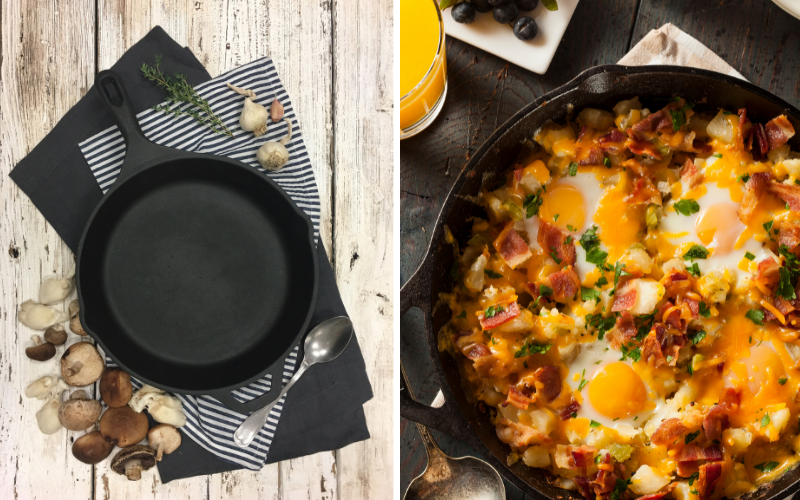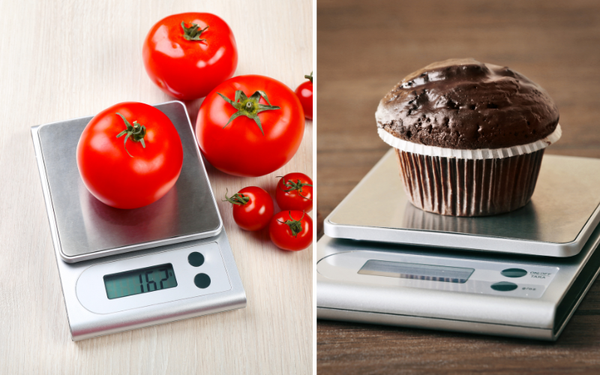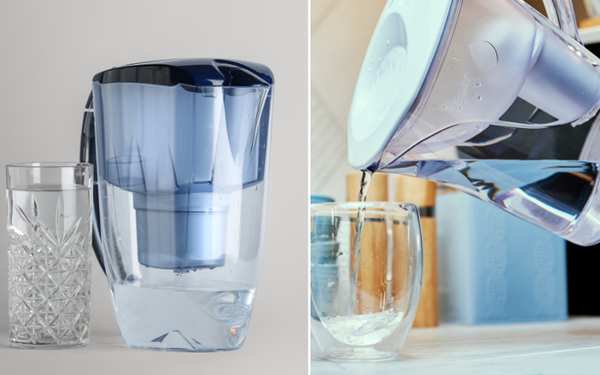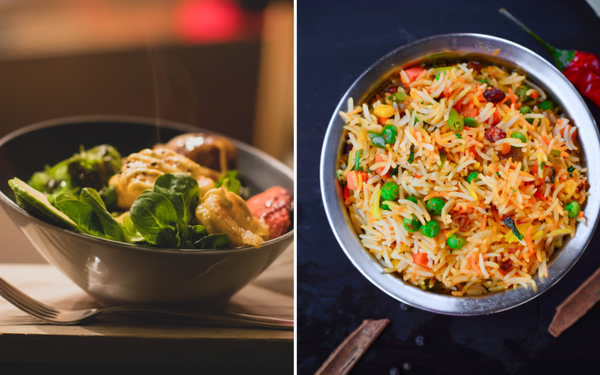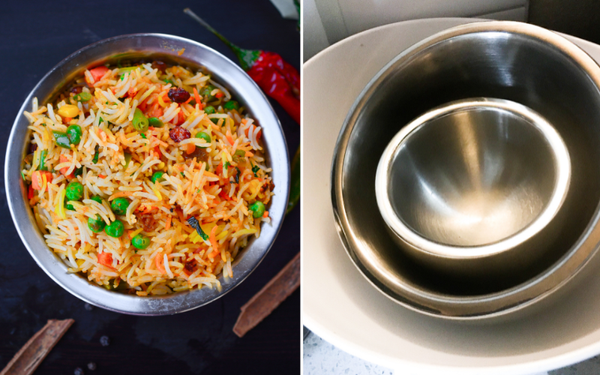When approaching stovetop cooking, the choice between a shallow or deep skillet isn’t just about size—it’s about matching the pan to the cooking method. A common question is: what is the difference between shallow and deep skillet? A shallow skillet is perfect for activities like flipping pancakes or searing a steak with minimum oil, thanks to its lower sides.
Choose a deep skillet when you’re simmering sauces or slow-cooking a stew, as its high walls can hold liquids better. This article will clarify what sets these skillets apart, helping you select the right pan for every recipe.
Key Takeaways
- Shallow skillets have sloped sidewalls and are best for shallow frying and easy food flipping, while deep skillets are great for simmering and braising with their higher, straight walls.
- Key to cooking success lies in skillet design - shallow for frying and sautéing with less oil, deep for versatility in cooking styles like sautéing, deep frying, and braising.
- Correct skillet care, including cleaning, seasoning, and storing, is vital for longevity and maintaining non-stick properties, with material choice (cast iron, stainless steel, non-stick) impacting cooking style and heat distribution.
Understanding Skillets: Shallow vs Deep
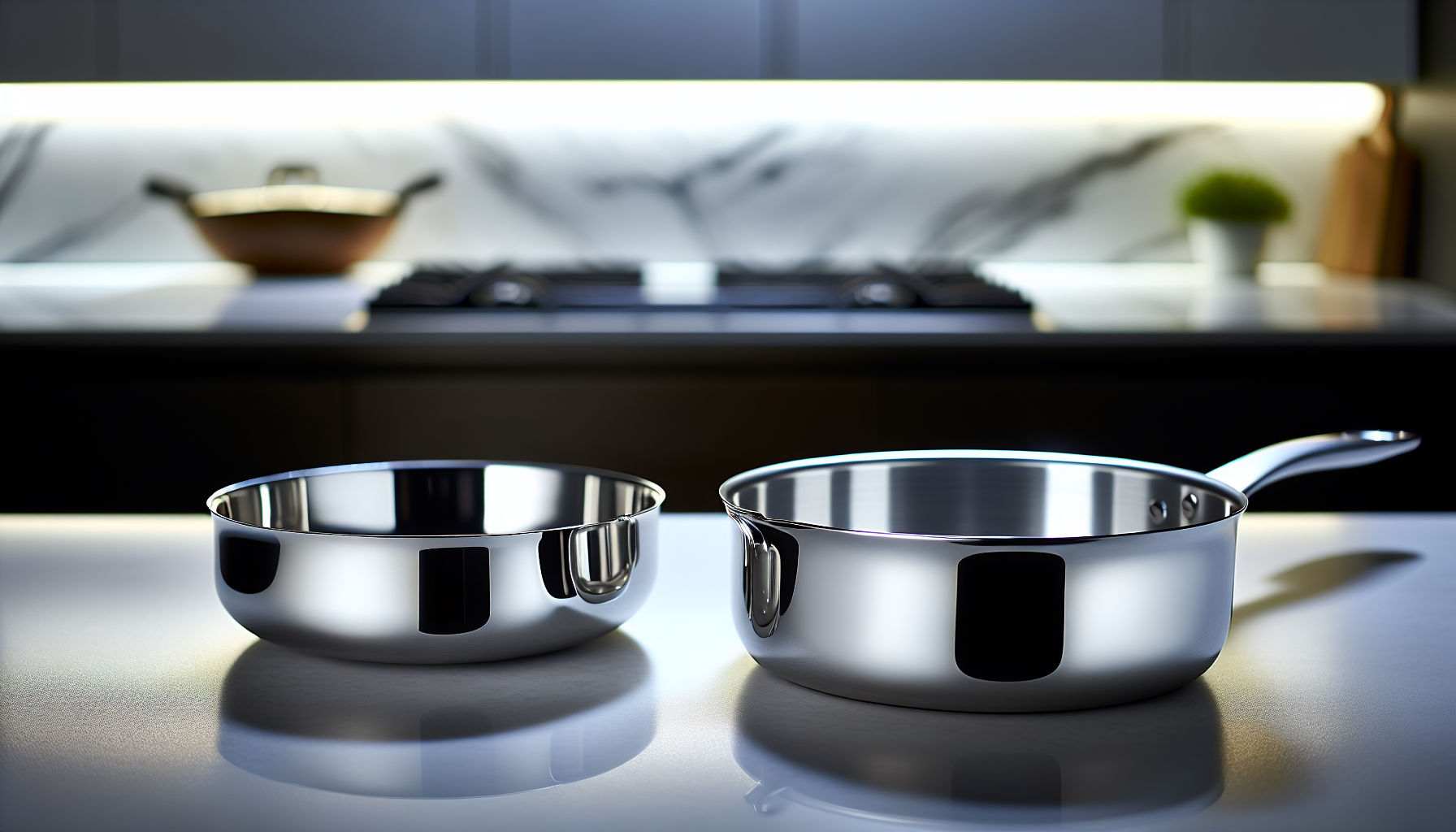
The diversity of skillets matches the variety of dishes we create in our kitchens. Shallow and deep skillets, as their names suggest, vary in depth. While they might look quite similar, their design significantly influences their cooking function. Picture this: a shallow skillet, with its sloped sidewalls and a wider rim, perfect for flipping an omelet with ease!
Contrarily, deep skillets, characterized by their higher, straight walls, eagerly await simmering a hearty stew. So, what’s the ideal skillet for frying or sautéing? It’s the shallow type! Its structure makes it less suited for methods requiring copious amounts of oil, like deep frying. Its design advantageously allows for the ease of food-flipping and uses less oil, making it quite the shallow frying superstar.
Design and Structure
The key to a skillet’s functionality is rooted in its design. Shallow and deep skillets, though seemingly similar, have distinct structural elements that cater to different cooking methods. The shallow skillet, with its gently sloping sides, offers a wider rim compared to the cooking surface. This design promotes easy maneuvering of food, making it ideal for flipping pancakes or sautéing veggies.
In contrast, deep skillets, with their high, straight walls, provide a depth that can accommodate a larger volume of food or liquid, making them perfect for braising meats or simmering sauces. So, whether you’re planning to shallow fry or deep fry, the skillet’s design plays a crucial role in determining the result.
Cooking Purposes
Your choice of skillet can significantly impact your cooking. Take shallow skillets for instance. They’re typically used for shallow frying, a hot oil-based cooking technique that’s just perfect for portion-sized cuts of meat, fish, or those crispy potato fritters that we all love. Shallow frying operates at medium-high to high heat, with temperatures ranging from 320–374 °F. This promotes browning and triggers a Maillard reaction, a chemical reaction that enhances flavor in foods that are often turned over partway through the cooking process. Imagine the golden-brown crust on your fried chicken or that beautiful sear on your steak; that’s the magic of shallow frying!
Deep skillets, on the other hand, are quite the versatile tool in your kitchen arsenal. They can accommodate a variety of cooking styles, including:
- Sautéing
- Deep frying
- Braising
- Searing
- Creating charred textures
Each cooking style contributes to different texture and flavor profiles. Deep skillets provide the necessary depth to tenderize and infuse flavors into meats, resulting in tender and flavorful braised meats. The versatility of deep skillets also allows for layering flavors, such as sautéing aromatics before searing meats or creating a delightful charred texture on pork chops. So, depending on whether you’re in the mood for crispy fried chicken or a hearty meat stew, the choice of skillet can significantly influence the outcome.
Heat Distribution and Temperature Control
Achieving the correct temperature is vital for a perfectly cooked meal. Whether you’re using a shallow or deep skillet, preheating the pan and oil to the right setting until they reach the desired temperature is crucial for regulating temperature when frying. This is especially important when frying multiple batches, as you need to allow the oil temperature to recover and maintain the heat setting to avoid overheating.
Cast iron skillets, known for their heat retention, can enhance the flavor and crispiness of cooking foods like fried chicken, roasted vegetables, or even french fries, making them a favorite choice for cooking food. Additionally, preheating is crucial during stir-frying, as it enhances forced evaporation. Without preheating, the liquids from vegetables may steam instead of evaporate, altering the cooking process.
Furthermore, the thickness of the pan can affect heat conduction. Thicker pans tend to be more durable, but they might not conduct heat as quickly as thinner ones. So, the next time you’re in the kitchen, remember: it’s all about heat control!
Choosing the Right Skillet for Your Cooking Needs
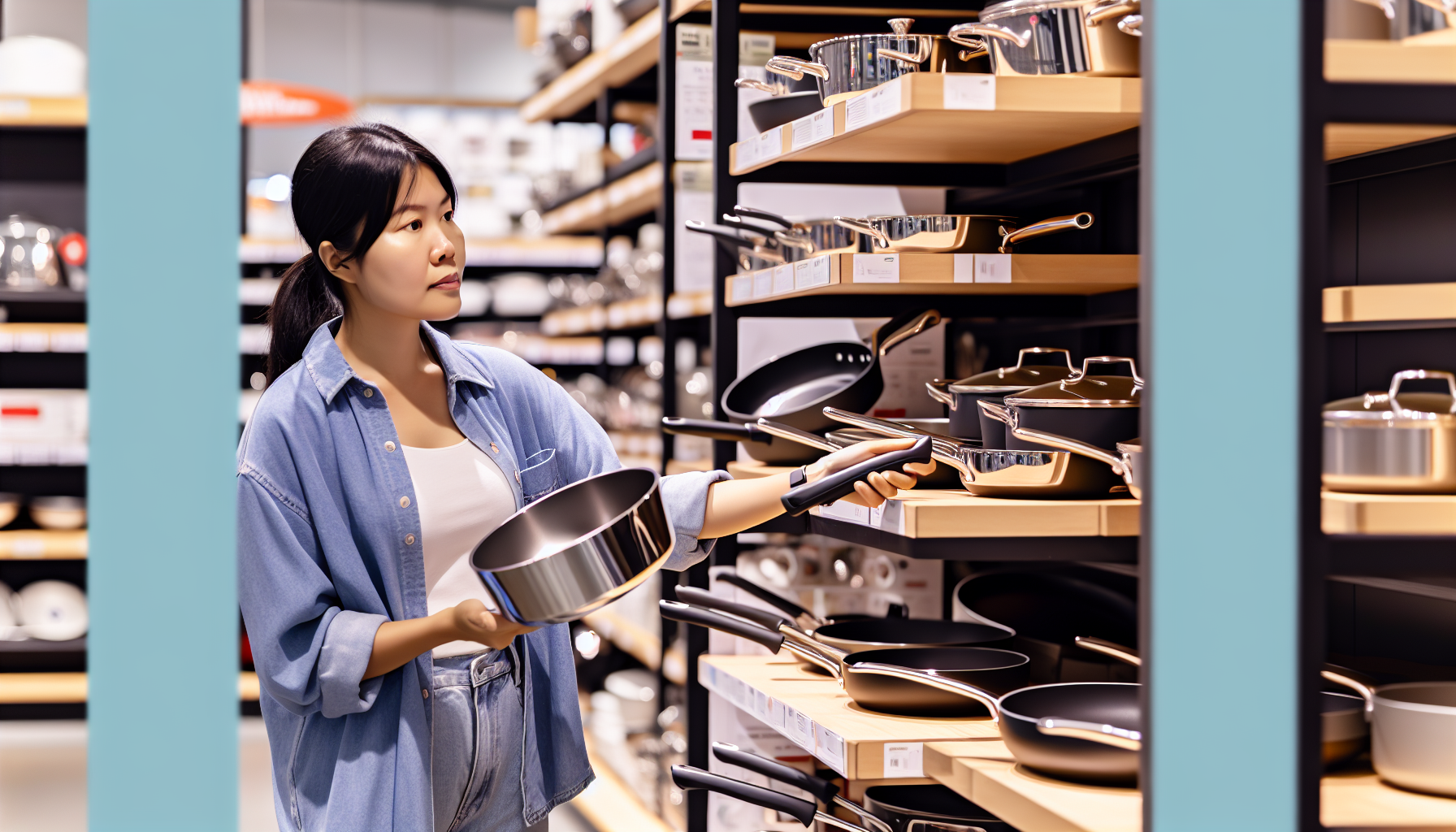
Selecting the appropriate skillet goes beyond just choosing the most durable or priciest option. It’s about understanding the factors that can influence your cooking experience, including the type of food you’re cooking, your cooking style, and the desired outcome.
Do you prefer slow cooking or braising your meat? Then a deep skillet might be your best bet. If you’re more into frying and sautéing vegetables, a shallow skillet with its increased surface area and easier maneuverability is the way to go.
So, whether you’re planning to cook a liquid-based dish that requires a deep skillet to handle more volume without spillage, or you’re aiming for a well-browned crust on your food that a shallow skillet can offer due to its lower sides permitting better evaporation of moisture, the right skillet can make all the difference!
Food Type Compatibility
Your choice of skillet significantly depends on the type of food you intend to cook. Shallow skillets, with their short sides and wide cooking surface, are ideal for frying, searing, and browning foods. Whether you’re planning to cook a delicious beef stroganoff, Brussels sprouts with bacon, or a simple pan-fried fish, a shallow skillet is the perfect tool for the job.
Deep skillets, or sauté pans, on the other hand, have higher sides that make them suitable for cooking with liquids and for meals with less splatter. They excel in preparing saute pan recipes such as:
- skillet suppers
- skillet brownies
- Dutch baby pancakes
- skillet cakes
- mixed berry crisps
If you’re aiming for a smoky flavor, like in smoky skillet-grilled chicken, a deep skillet is your best friend.
So, depending on what you’re cooking, your skillet choice can either make your meal a hit or a miss.
Desired Outcome and Texture
The skillet’s depth can substantially affect the texture and result of your dish. For example, shallow pans are ideal for achieving a crispy and golden-brown crust on foods such as pan-fried fish while keeping the flesh tender inside. Skillets, especially when used with a pressing technique, can help attain a crispy-edged texture, as evidenced in dishes like king oyster mushroom steaks.
On the other hand, deep skillets are excellent for recipes requiring simmering, as they can maintain liquid content without reducing too quickly. So, if you’re aiming for a savory, slow-cooked stew or a crispy, golden brown chicken, the depth of your skillet can make all the difference. And don’t forget, a well-seasoned skillet is essential for achieving an ideal sear on meats, which not only improves flavor and texture but also prevents sticking.
With the right skillet, you’ll be able to bring out the best flavors and textures in your dishes!
Cooking Style Preferences
Each individual boasts a unique cooking style in the kitchen. Some love the quick stir-fry, while others prefer the slow, savory stew. Your personal cooking style can greatly influence the type of skillet you should opt for. Chefs who prefer to cook and serve in the same pan may opt for deep skillets, which are suitable for dishes like paella and skillet desserts that are presented at the table. Shallow frying pans are ideal for those who prefer quick and easy meals, such as a 15-minute Asian beef stir-fry or one-pan dishes like spicy tomato and capsicum meatball shakshuka, which also simplifies the cleanup process.
Individuals with specific dietary preferences or restrictions, such as vegetarianism or a gluten-free diet, can efficiently utilize shallow frying pans to prepare dishes like zucchini and egg rice pie. So, whether you’re a fast-paced stir-fry enthusiast or a slow-cooking stew lover, there’s a frying pan out there that’s just right for you!
Caring for Your Skillet: Maintenance and Cleaning Tips
For optimal skillet usage, appropriate care and maintenance are essential. From cleaning and seasoning to storing and handling, every step is crucial in preserving the functionality and longevity of your skillet.
Whether you’re a fan of stainless steel skillets, which should be hand-washed with mild detergent and warm water, or you prefer cast iron skillets, which require a unique cleaning process using kosher salt and hot water, knowing how to care for your skillet can make a world of difference in your cooking experience.
Proper Seasoning Techniques
Correct seasoning is a vital step in preserving your skillet, particularly if it’s crafted from cast iron or stainless steel. For a new cast iron skillet, start by:
- Washing it with warm, soapy water to remove any residue.
- Drying it thoroughly and heating it over a stovetop flame for a couple of minutes to eliminate all moisture.
- Once the skillet is dry and hot, apply a layer of a high-smoke point cooking oil to its surface and buff it until it appears non-greasy.
- Place the skillet upside down in a preheated 450°F oven for 30 minutes to allow the oil to bake into the surface and begin forming a protective seasoning layer.
- Repeat the oiling and heating stages three to four times for a robust initial seasoning.
Properly seasoned cast iron skillets develop a natural non-stick surface that gets better with every use, providing an excellent cooking experience from the start.
But what about stainless steel skillets? While they don’t require traditional seasoning like cast iron, seasoning a stainless steel skillet can create a non-stick layer that is especially beneficial for delicate foods that tend to stick, like eggs or crepes. So, whether you’re a cast iron enthusiast or a stainless steel fan, proper seasoning is a skillet-care step you can’t afford to skip.
Cleaning Methods
Properly cleaning your skillet holds equal importance as seasoning it. Here are the steps to clean a cast iron skillet:
- Use kosher salt and hot water to scrub away stuck-on food.
- Rinse the skillet with hot water.
- Towel dry the skillet.
- Coat the skillet with a light layer of cooking oil before storage in a dry place.
For stubborn food residue, boiling water in the pan can help loosen the bits for easier removal.
On the other hand, non-stick pans require gentle hand-washing with a soft sponge to ensure the non-stick surface is not damaged. After using a non-stick skillet, it’s best to wash it immediately with hot, soapy water to prevent residue from sticking. For burnt-on food, boiling a solution of white vinegar and water can assist in removing the residue after cooling.
So, whether you’re cleaning a cast iron or a non-stick skillet, it’s crucial to follow the correct cleaning methods to maintain your skillet’s condition and prolong its lifespan.
Storage and Handling
Correct storage and handling of your skillet can avert damage and preserve its surface integrity. To prevent scratches or other damage, it is advisable to avoid using sharp utensils on your skillet and use pan protectors when necessary. Skillets can be stored effectively by hanging them on a pot rack or utilizing wall-mounted pegboards. They should be placed in a way that prevents stacked cookware from causing scratches or other damage.
Cast iron skillets should be stored in a dry place to avoid rust and maintain seasoning, while non-stick skillets should be dried thoroughly after cleaning and may benefit from a light rub of oil to protect their surface. So, whether you’re storing your skillet after a hearty meal or handling it during a bustling cooking session, taking good care of your skillet can ensure it remains an essential part of your kitchen for many years to come.
Common Skillet Materials and Their Benefits

Skillets come in a range of materials, each presenting distinct advantages. Here are some of the most common skillet materials and their benefits:
- Cast iron: known for its excellent heat retention and even heat distribution
- Stainless steel: durable and provides even heat distribution
- Non-stick: offers ease of use and easy cleaning, but requires careful handling to avoid damaging the surface
Each skillet material brings something unique to the table, so consider your cooking needs and preferences when choosing the right skillet for you.
So, whether you’re a seasoned chef or a cooking enthusiast, understanding the different skillet materials can help you choose the right skillet for your culinary endeavors. In addition, having the right metal cooking utensils can make a significant difference in your cooking experience.
Cast Iron Skillets
Cast iron skillets, a traditional pick in numerous kitchens, are cherished for their:
- Uniform and steady heating
- Excellent heat retention
- Resistance to high temperatures
- Durability with regular maintenance
Despite not spreading heat evenly across the pan, their ability to retain heat provides a stable cooking surface once the desired temperature is reached. This makes them perfect for baking items like skillet cornbread that benefit from consistent heat during the cooking process.
Durability is another key characteristic of cast iron skillets, allowing for a long lifespan and the ability to withstand high heat, which is essential for various cooking methods. Plus, you can use metal utensils on cast iron skillets without damaging the surface, provided they are properly seasoned. So, whether you’re planning to simmer a rich stew or bake a sweet treat, a cast iron skillet is a reliable and versatile tool to have in your kitchen arsenal.
Stainless Steel Skillets
Stainless steel skillets also rank high in popularity, thanks to their multitude of advantages. They are highly durable and can last a lifetime, making them a great long-term investment for a kitchen. Stainless steel skillets are excellent at retaining heat, providing even cooking which is beneficial for a range of cooking methods, including small-batch baking. However, a carbon steel pan is another option to consider for its own unique benefits.
A unique feature of stainless steel skillets is their 3-ply design, incorporating stainless steel and aluminum. This design offers improved heat conductivity and a more uniform cooking surface. Additionally, the non-toxic nature of stainless steel protects the safety of food, avoiding the risk of leaching harmful substances during cooking.
So, if you’re looking for a skillet that’s durable, efficient, and safe, a stainless steel skillet might just be the answer.
Non-Stick Skillets
Many, particularly those who value effortless cooking and cleaning, prefer non-stick skillets. They are ideal for cooking delicate foods like fish, fried eggs, and pancakes that tend to stick, simplifying the cooking and cleaning process. It is advised to cook at low to medium heat with non-stick skillets, as excessive heat can lead to the coating degrading or releasing harmful chemicals.
Despite their convenience, non-stick skillets require careful handling to avoid damaging the surface. Using non-stick cooking spray on non-stick pans is not advisable as it may damage the surface; instead, opt for hand washing to maintain the pan’s condition.
Furthermore, non-stick skillets may not be the best choice for recipes that require browning or searing due to their limitation in withstanding high-heat cooking. Nonetheless, with the right care and proper use, a non-stick skillet can be a valuable addition to your kitchen.
Tips for Cooking with Shallow and Deep Skillets
Having delved into the world of skillets, let’s examine some useful tips for cooking with both shallow and deep variants. Whether you’re searing a steak in a shallow skillet or simmering a hearty stew in a deep one, knowing how to preheat, control the temperature, and select the right oil can make all the difference in your cooking results.
So, let’s turn up the heat and get cooking!
Preheating and Temperature Control
Preheating is a fundamental step when cooking with skillets. Whether you’re using a shallow or deep skillet, preheating the pan is crucial for rapid heat transfer to the food, which helps to prevent overcooking and reduce cooking time. Stainless steel pans, which aren’t naturally non-stick, achieve better results and food release when properly preheated and paired with suitable cooking oils.
For deep cast iron skillets, here are some tips for more even cooking:
- Preheat the skillet, particularly in the oven, to create a more uniform temperature throughout, benefiting the cooking of larger batches or bigger pieces of food.
- Avoid adjusting the temperature setting after the skillet has reached a steady state, as this can trigger overcorrection and lead to inconsistent cooking outcomes.
- Use a diffuser under a large or deep skillet when cooking on a burner to promote more even heat distribution.
So, the next time you’re in the kitchen, remember to preheat your skillet for the best cooking results.
Oil Usage and Selection
Your choice of oil for your skillet can notably influence your dish. Here are some options to consider:
- Shallow frying: considered a healthier option due to less oil absorption, making it suitable for those conscious about fat intake.
- Deep frying: provides a fried texture with less oil usage, but has a higher calorie and fat content.
- Sautéing: uses a small amount of oil to quickly cook ingredients over high heat.
- Stir-frying: similar to sautéing, but with constant stirring and tossing of ingredients.
- Pan-frying: uses more oil than sautéing, allowing for a crispy exterior.
- Grilling: uses no oil, relying on direct heat to cook the food.
Consider these options based on your desired outcome and dietary preferences.
When selecting oils for your skillet, it’s important to consider the oil’s smoke point. For shallow frying, using oils with moderate to high smoke points like:
- olive oil
- avocado oil
- canola oil
- corn oil
Shallow frying is recommended, as it helps in reducing excess oil. Using very little oil, refined olive oil, more stable at high heat, is better suited for shallow frying compared to extra-virgin olive oil.
Meanwhile, for deep frying, high smoke point oils like canola or peanut oil with neutral flavors are ideal. So, picking the right oil can be just as important as choosing the right skillet for your cooking adventures.
Safety Precautions
Kitchen safety should always be paramount, and this includes skillets. For non-stick skillets, it’s important to prevent damage to the coating to maintain both safety and non-stick performance. This means never heating a non-stick pan while empty, avoiding cutting foods in the pan or scraping the surface with sharp objects.
In addition to these, general safety precautions when using skillets include avoiding overcrowding the skillet, using oils with high smoke points to reduce the chance of burning, and stirring or flipping the food regularly. By following these safety precautions, you can ensure a safe and enjoyable cooking experience with your skillet.
Summary
In the world of cooking, choosing the right skillet can change the game. Whether it’s a shallow or deep skillet, each brings its unique benefits to the table. Understanding the differences between skillets, including their design, cooking purposes, and heat distribution, can help you choose the best one for your needs. Whether you’re shallow frying a juicy steak, simmering a hearty stew, or baking a sweet treat, your skillet choice can make all the difference. So, the next time you step into your kitchen, remember: the right skillet can take your culinary creations from good to extraordinary!
Frequently Asked Questions
Which is better deep fry or shallow fry?
Shallow frying is better because it uses less oil, making it a bit healthier. It involves cooking food in oil with a depth that reaches about half of the thickness of the food, with the food touching the bottom of the pan. Try it out!
What do you use a deep skillet for?
A deep skillet is great for sautéing meats and fish, and for finishing dishes with a sauce, thanks to its design that reduces splashing and allows for easy use with a whisk. This makes it very practical for cooking a variety of dishes.
What is a shallow frying pan used for?
A shallow frying pan is typically used for cooking portion-sized cuts of meat, fish, potatoes, and patties, such as fries. It is also suitable for cooking vegetables.
What is the difference between shallow and deep skillets?
Shallow skillets have sloped sides and are better for frying, while deep skillets have higher, straight walls and are great for cooking with liquids and larger volumes of food.
How does the design of a skillet influence its cooking function?
The design of a skillet significantly influences its cooking function. For example, sloped sides make it easy to flip food for frying, while high, straight walls provide depth for braising meats or simmering sauces.
You Might Also Like...
